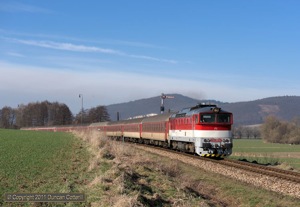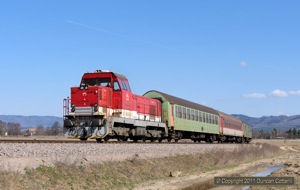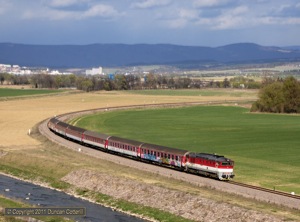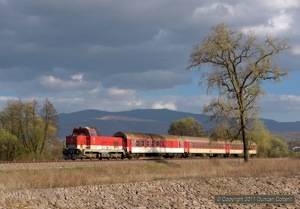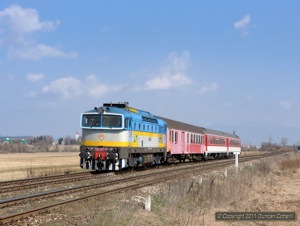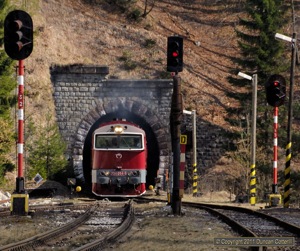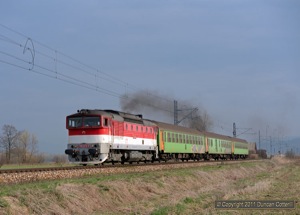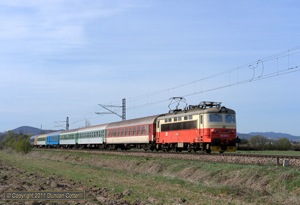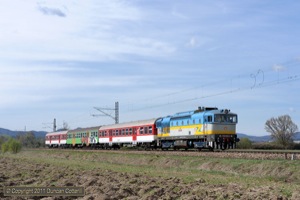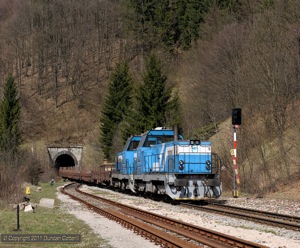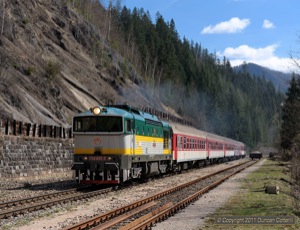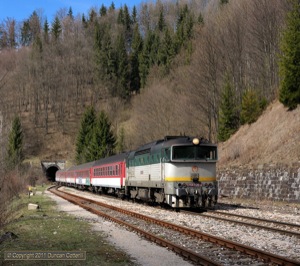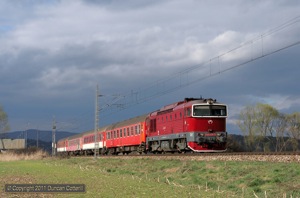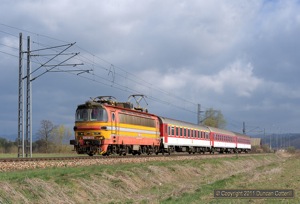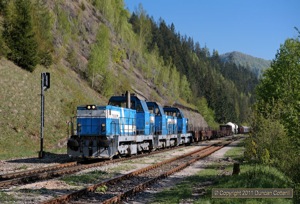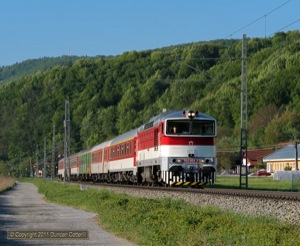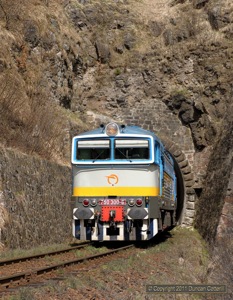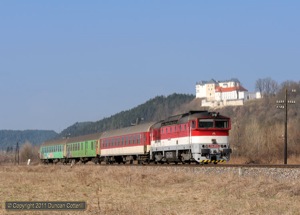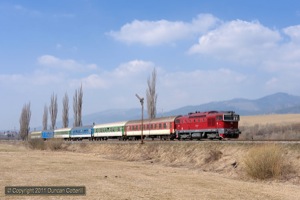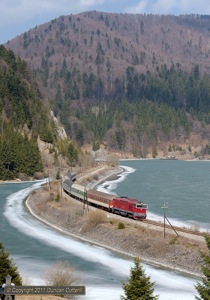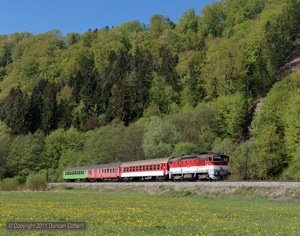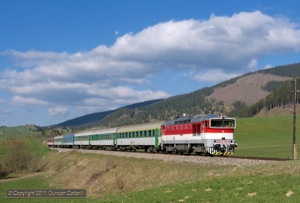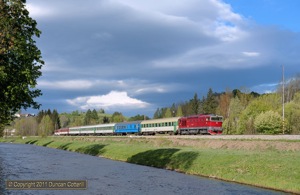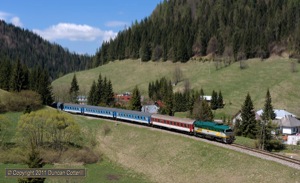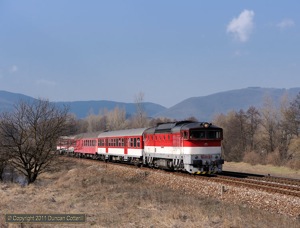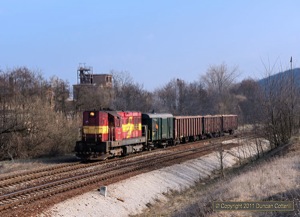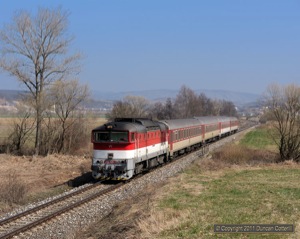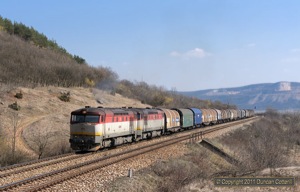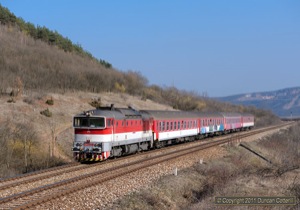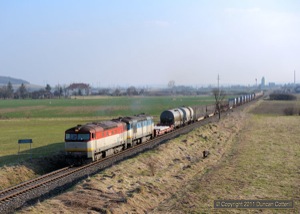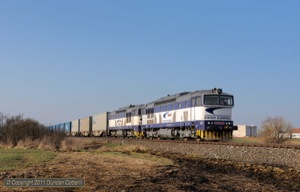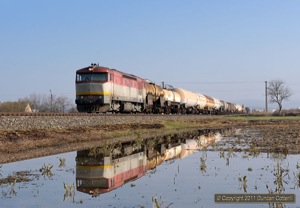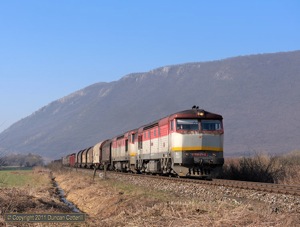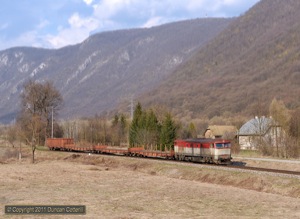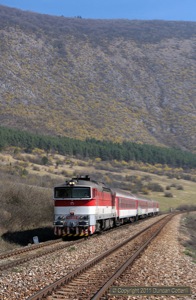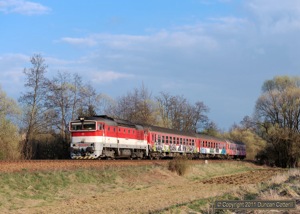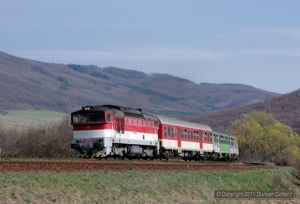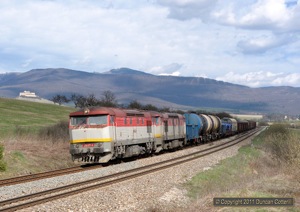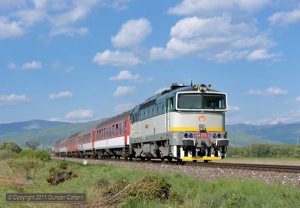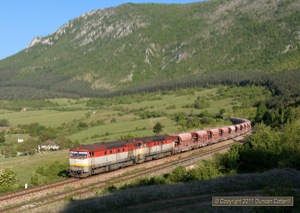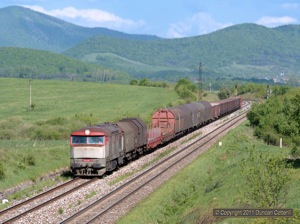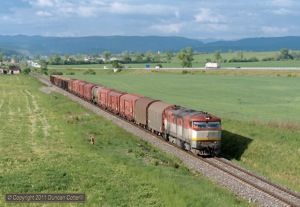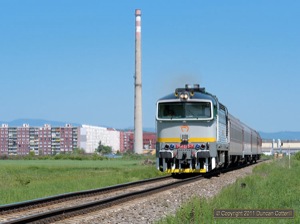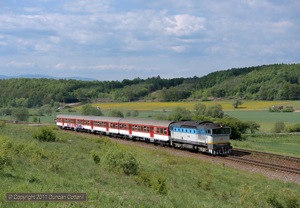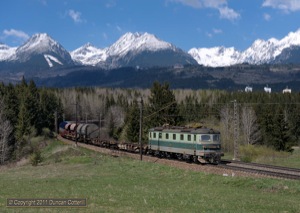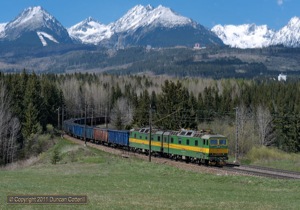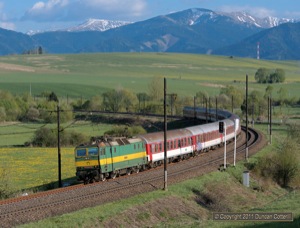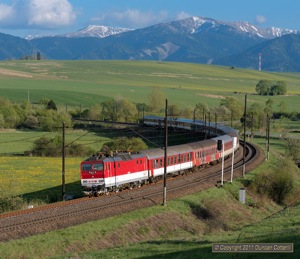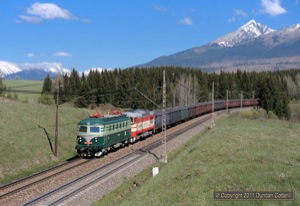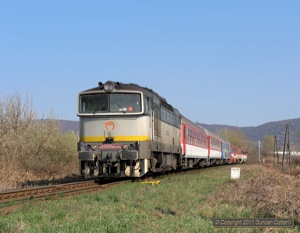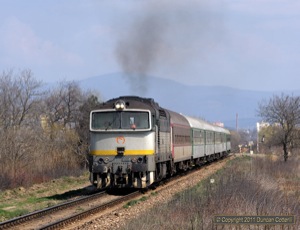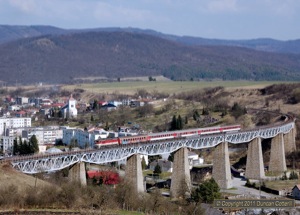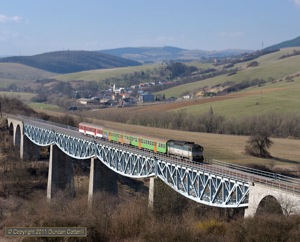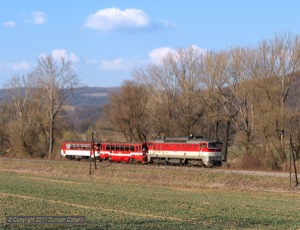Slovak Diesels
26 March - 11 April & 02 - 13 May 2011
Report by Duncan Cotterill
Introduction
This report covers a pair of two week photographic trips to Slovakia in the Spring of 2011, from 26 March to 11 April and from 2 to 13 May. While the country shares much of its railway and cultural heritage with the Czech Republic there are significant differences between the two places and their railways that make a visit very worthwhile, even to an experienced Czech hand. I’d been to Slovakia before, in 2001 and again in 2003 but a lot had changed in the intervening years.
Both trips started with a few days in the Czech Republic and I returned there at the end of each trip (first Czech report here, second Czech report here). Travel was by hire car, essential due to the poor local train services in Slovakia. Most of the diesel worked lines from Prievidza through Zvolen and Roznava to the eastern borders were visited during the course of the first trip, while the second concentrated on the Zvolen and Roznava areas with a short visit to the main east-west electric line at Strba.
This section of the report summarises what was seen. For train by train details with loco numbers etc, go to the Day by Day pages.
Prievidza Area
(26 - 27 Mar and 9 - 10 April)I have to admit that I hadn’t heard of Prievidza until last autumn. It lies at the north end of a long single-track secondary line from Nove Zamky (Table 140) that runs through a number of medium sized towns and is served by a mixture of loco hauled passengers and railbuses. For most of its length, the line runs through nondescript, flat, farming country but north of Partizanske it gets close to the hills for the last few km, through Novaky to Prievidza. The section between Novaky and Kos, the last halt before Prievidza is also interesting for the fact that it’s recently been relocated to avoid what appears to be an area of mining subsidence.
Passenger trains on the line are worked by a mixture of class 750 and class 736 (rebuilt 735) diesel locos and railbuses but, like most lines in Slovakia, services are sparse for much of the day and virtually non-existent for most of the morning. As well as local passengers there are a handful of through trains to or from Bratislava that load to 6 coaches or more and are hauled by a class 750 diesel from Prievidza to Leopoldov, where an electric takes over.
The Prievidza area has a number of active coal mines and is responsible for more than half of Slovakia’s modest coal production but it doesn’t generate a massive amount of rail freight traffic. Almost all the coal mined is consumed locally, principally by the power station at Zemianske Kostolany, near Novaky, and there is even some inbound coal traffic. My visits were both at the weekend so I didn’t see much in the way of freights, only an empty coal train heading south from Zemianske Kostolany behind a PSZ (Prva Slovenska Zelezniena = First Slovak Railway) class 740 on the morning of 10 April. I’d read somewhere that independent operators handled a significant proportion of Slovak freight traffic but this was the only evidence I saw of private operation on ZSR metals. I did see a number of ZSSK-C class 751s, which are booked to work most of the freight in the area as well as a few class 721s and 742s, used for shunting and pick-up freights, but they weren’t actually working trains at the time.
The line is a challenge photographically but I did manage to find a few reasonable locations, all of them between Partizanske and Prievidza. There were morning shots at the west end of Olsany and the east end of Bystricany, both featuring semaphore signals, and the relocated section between Kos and Novaky was good in the afternoon, especially the late afternoon when the light had gone round far enough to allow shots from the hills that overlook the north-western part of the curve. Access is possible via a riverside footpath/cycle track that runs from Novaky to Opatovce nad Nitrou.
Prievidza has a small loco depot which was visited on 26 March. Nobody took a blind bit of notice as I wandered round. As well as the ZSSK and ZSSK-C traction, a couple of preserved locos were present; 4-8-4T 464.001 and diesel T444.0055. The most scenic line from Prievidza crosses the mountains to Horna Stubna on the line from Hronska Dubrava via Kremnica to Turcianske Teplice. Passenger services are all worked by railbuses and the freights are all timed to run at night.
Zvolen - Vrutky
(28 - 29 Mar, 1, 6, 8, 9 Apr and 3, 4, 12 May)Zvolen is an important railway junction, industrial centre and university town in south-central Slovakia. The line to Vrutky (Table 170) is a significant north-south link connecting some of the most important towns in central Slovakia. It can be considered in three sections, each of which has a character of its own.
Zvolen - Banska Bystrica
The first section runs north from Zvolen, along a broad valley to Banska Bystrica, the regional capital and sixth largest city in Slovakia. The line is single-track and was electrified at 25kV 50Hz AC a few years ago.
Passenger traffic is fairly heavy with at least one train each way an hour for most of the day and more at the peaks. Most trains are loco hauled by a variety of power including class 750 and 754 diesels and class 240 and 242 electrics. The 242s are CD machines balancing mileages with ZSSK locos working in the Czech Republic. There should be a number of workings for class 263 electrics as well but most of the trains I saw that were booked for the class turned up with 242s instead. R835 seemed to be the only train that was actually worked by a 263. A handful of trains are booked for railbuses.
The line sees a few freights but all those I saw were hauled by diesels. The through Zvolen - Vrutky trains are booked for haulage by pairs of class 756 diesels, rebuilds of class 750/753s, very similar to the Czech class 753.7s. In reality, pairs of 736 seemed to be the norm and a 751+736 combination was seen on one occasion. Local freights are worked by class 742 diesels.
One very unusual sighting was of 757.001, the prototype rebuilt class 750 from ZOS Vrutky, equipped with a 1260kW Caterpillar engine, painted in ZSSK red and white livery and silent rather than silenced. According to www.railpage.net it was formerly 750.092. The loco was seen heading north from Zvolen towards Banska Bystrica with a test train on 4 May.
There are some reasonable photo positions between Sliac and Vlkanova, particularly around Velka Luka. Although the line is flat, there are distant hills and the landscape is pleasant. This area also appeared to be a bit of a sun trap with the cloud breaking at times when it was cloudy all around. North of Vlkanova the hills close in but the line is heavily treed and the only worthwhile location noted was an afternoon shot south of Radvan, on the outskirts of Banska Bystrica.
Banska Bystrica - Turcianske Teplice
The next section runs from Banska Bystrica north-westwards over the mountains to Turcianske Teplice. The electrification ends at Banska Bystrica and the section onwards is entirely diesel worked, single-track and steeply graded. The climb begins at the end of Banska Bystrica station and the line then twists its way via a series of tunnels and horseshoe curves up to a 4697m tunnel under the Maly Sturec Pass, west of Harmanec Jaskyna. From the west end of the tunnel at Cremosne, the line descends to reach the plains south of Turcianske Teplice but without any tunnels or horseshoe curves.
This section sees relatively few passenger trains with gaps of two hours or more the norm. Most trains are loco hauled by class 750 or 754 diesels but a few off-peak services are covered by railbuses. Freight traffic is also fairly sparse but there were one or two freights on each of the two afternoons I spent on the line. The heaviest trains were double headed and double banked with a pair of 736s on the south end and a pair of 751s on the north end. A couple of freights seen were worked by triple headed class 736s.
The main problem facing photographers is getting access to the most scenic sections of the line, which is often perched high on rocky mountainsides, well away from roads and public footpaths. Fortunately a couple of the stations are quite attractive and much more accessible, although, for car based photographers, there’s a long and very steep climb up from the road. I spent several afternoons around Harmanec Jaskyna and Dolny Harmanec, both worth a visit although the lampposts at Jaskyna are a pain. Other spots were noted from the train just north of Kostiviarska (no trains at the right time for the shot), just east of Harmanec (couldn’t find the way up from the road to Harmanec) and in the middle of the forest west of Cremosne. There are a couple of more accessible spots on the curve between the halt at Horna Stubna obec and the junction with line 171 at Dolna Stubna odbocka, south of Turcianske Teplice.
Turcianske Teplice - Vrutky
From Turcianske Teplice the line runs north along a broad valley through the industrial city of Martin and on to the neighbouring town of Vrutky on Slovakia’s principal east-west main line. The line is double-track, a reflection of past traffic levels rather than current requirements, and from Martin to Vrutky, it’s electrified at 3000V DC.
There are more passenger trains than on the Banska Bystrica - Turcianske Teplice section with additional services from Vrutky to Prievidza (via Horna Stubna and Handlova) and to Zvolen (via Horna Stubna and Kremnica). All the Prievidza trains and most of those via Kremnica are railbuses. In addition to the through freights via Banska Bystrica there is a 751 hauled pick-up goods on weekdays from Vrutky to Horna Stubna in the morning, returning during the afternoon.
Access isn’t a problem on this section of line but the available photo positions tend to be very flat and open and lacking in much interest apart from the trains.
Hronska Dubrava - Turcianske Teplice
(9 Apr and 3 May)This rural line forms part of an alternative route from Zvolen to Vrutky but only sees local traffic. The line leaves the main, electrified, Zvolen - Nove Zamky / Bratislava line after 11km, at Hronska Dubrava, and climbs to a summit high in the hills at Kremnicke Bane before descending through Horna Stubna, junction of the Prievidza line, to Dolna Stubna odbocka, south of Turcianske Teplice, where it joins the line from Zvolen via Banska Bystrica.
Most passenger trains are worked by railbuses but there are a handful of class 750 hauled trains over the line, usually at inconvenient times but including a pair in the middle of the day on Saturdays and Sundays. Freight traffic is virtually non-existent apart from the few services north of Horna Stubna mentioned above.
Like the Banska Bystrica - Turcianske Teplice section of table 170, this line runs through very attractive mountainous scenery but there are few good photo positions. I spent very little time here, driving north on the morning of Saturday 9 April and eventually finding a couple of reasonable positions for the midday trains near Turcek. It was hoped that a ride over the line on 3 May would reveal more positions but it didn’t. Practically the whole line is heavily overgrown.
Banska Bystrica - Cervena Skala - Margecany
(29 Mar, 1 Apr and 2, 4, 5, 7, 9, 10 May)This long east-west, single-track, cross-country line (Tables 172 and 173) runs for miles through remote, sparsely populated, mountainous country. From Banska Bystrica, the line follows the river Hron eastwards for almost 100km through the town of Brezno to a summit 947m above sea level in a tunnel under the Besnik Pass, east of Telgart. This is the highest point on the Slovak standard gauge system. From the summit the line continues east for another 80km along the valley of the river Hlinec to Margecany where it meets the electrified Zilina - Kosice main line. The most interesting features are the spiral tunnel and two viaducts at Telgart penzion, near the summit of the pass, and a causeway across the Palcmanska Masa reservior near Dedinky.
Despite its rural nature, the line sees a fair number of class 750 and 754 hauled passenger trains at its western end. Around half the trains between Banska Bystrica and Brezno are hauled with the rest worked by 4-wheel railbuses. East of Brezno, railbuses rule and there is only one pair of loco hauled trains, R811 eastwards and R810 westwards. These trains are actually through services from Bratislava to Kosice and v.v. and, even more surprisingly, don’t take much longer than trains over the electrified main line via Zilina.
There are no through freights but pick-up goods trains work both ends of the line although they’re no longer scheduled to meet at Cervena Skala. The trains at the west end are booked for class 742s while a class 731 should work the east end. On 1 April, when I travelled the line, the pick-up at the east end was worked by a class 721 instead.
This is a superbly scenic line but it’s not particularly easy to photograph. The spots are there but they can take a lot of finding. The presence of telegraph poles on the south side of the line most of the way doesn’t help, particularly where they’re strung with low hanging cables. I had intended spending more time on this line on the first trip but mixed weather drove me to lines where I would get more than one chance of a shot. On the second trip I made a point of trying to intercept either R811 or R810 whenever practical but still only covered a fraction of the available spots. Definitely one to go back to.
Zvolen - Kosice
(29-31 Mar, 1-2, 4-7 Apr, 3-7 and 9-12 May)The long, diesel worked, secondary main line from Zvolen to Kosice via Lucenec, Filakovo, Plesivec and Roznava runs from west to east across southern Slovakia, often only a few km from the Hungarian border. It forms one of only three east-west links, the others being the electrified main line via Zilina in the north and the mountainous Banska Bystrica - Margecany line described above. Although the line is lower lying and more suitable for freight traffic than the Margecany line, it does have some sections with significant gradients that make operations more interesting. Like the Zvolen - Vrutky line, I’ve divided the description into three sections based on geography and the way the line is operated.
Zvolen - Filakovo
The westernmost section runs 69km from Zvolen to Filakovo. The line climbs gently for 26km from Zvolen to Krivan through attractive open countryside. Just east of Krivan, it crosses the watershed and begins a steep descent down a narrow, winding, wooded valley for 14km to Lovinobana. The scenery then opens out again before the line reaches the important regional centre of Lucenec, 54km from Zvolen, and remains fairly open for the remaining 15km to Filakovo. The line is single track for most of its length but the first section from Zvolen to Slatinka (9km) and the steeply graded section from Krivan to Lovinobana are double track.
The long distance passenger service consists of four fast trains a day linking Zvolen with Kosice and hauled by Zvolen based class 754 diesels. One train each way runs overnight and some trains convey through coaches to/from Bratislava and/or Presov.
There is also a good local service running from Zvolen to Filakovo. Services run roughly every two-hours for most of the day but are hourly at peak times. Many of the local services are worked by locos of classes 750 and 754 although some off peak services are worked by 4-wheel railbuses and a few stop short at Lucenec.
A number of freights are booked to run over the line each day, rostered for locos of classes 736, 746 (rebuilt 742), 751 and 756, often in pairs and often banked up the grade from either Lucenec or Lovinobana to Krivan by a class 736. Only a handful of freights were booked to run at times when I was on the line and the impression I got was that most ran fairly close to the booked time but not always with the booked power. Pairs of class 736s seemed to predominate, except on the daily Zvolen - Kosice through freights, which were worked by pairs of class 756. No 751s were seen on this section of line despite their predominance elsewhere.
At the end of March, the pick-up goods from Zvolen to Lucenec and back was seen twice with a 742 in charge instead of the booked 746 but in April the train was 746 hauled. In May it was 742 hauled on both occasions it was seen.
On my previous trips to Slovakia in 2001 and 2003, the best photo location was at Podkrivan where a hillside overlooked a big curve near the top of the climb from Lovinobana. I was surprised just how much the vegetation had grown up over the intervening period. Not only was the shot impossible, it was difficult to believe that there had ever been a shot there. On the other hand, a clear bank on the west side of the line, just north of Lovinobana station looked just the same as it had done all those years ago. Other locations were found near Slatinka, Detva, Mytna, Podrecany and Holisa.
Filakovo - Plesivec
This is the central section of the line and in many ways the least interesting. From Filakovo, the route heads east along a valley between low hills to a summit at Hajnacka, 13km from Filakovo, then continues eastwards, descending along another valley between low hills to Jesenske, 29km from Filakovo. The next 35km east to Lenartovce and then north to Tornala are across fairly flat agricultural land dotted with small towns and villages. North of Tornala, the hills start to close in on both sides and the final 16km to Plesivec are a bit more scenic. The line is mainly single track with short double track sections from Dubovec to Rimavska Sec, east of Jesenske and the last 8km from Coltovo into Plesivec.
The passenger service east of Filakovo is very sparse with only the few fast trains and a meagre local service. Around six local trains each way leave Filakovo on weekdays (less at weekends) and run east to Jesenske where they turn north at to serve the large town of Rimavska Sobota. During my first trip most services connected at Jesenske with a train on to Plesivec but the service was dramatically reduced at the beginning of May, leaving only two services to Plesivec and a third stopping short at Tornala .
In addition to the class 754 hauled fast trains between Zvolen and Kosice, there is one class 750 hauled local from Filakovo to Rimavska Sobota and back on weekdays, everything else is railcar.
Freight traffic is reasonable with a number of trains hauled by locos of classes 736, 742, 746, 751 and 756, often in pairs. In addition to the classes listed, a class 752 was seen double heading one freight with a 751.
There are a number of photo positions between Tornala and Plesivec that are good for light in the mornings and late afternoon. The hilly section at the Filakovo end of the line also has some photographic potential but I haven’t tried any shots there yet.
Plesivec - Kosice
The eastern section of the line leaves Plesivec in a north-easterly direction and climbs up the Slana river valley for 13km to the regional centre of Roznava where it turns east to follow the Cremosna river. After another 7km the line turns to the south-east at Lipovnik and dives into a long tunnel under the Slovenske Kras mountains, emerging on the southern slopes of the mountains, high above the broad valley of the Turna river. For the next 15km, the line clings to the mountainsides, descending slowly past the villages of Jablonov nad Turnou and Hrhov to reach the valley floor at Dvorniky. The valley quickly broadens out into a plain and the remaining 44km to Kosice are fairly featureless.
The line has double track sections from Slavec Jaskyna most of the way to Roznava, from Roznava to Lipovnik, from the eastern portal of tunnel under the Slovenske Kras to Moldava nad Bodvou and from Velka Ida into Kosice. Velka Ida is adjacent to the Kosice steelworks and the line from there to Kosice is electrified at 3000V DC.
Despite the proximity of the line to Kosice, Slovakia’s second city, the passenger service is abysmal. The few class 754 hauled fast trains are joined by a handful of locals worked by railbuses but there are some very long gaps. The service was reduced further at the beginning of May so there are now only two trains a day over the 44km from Plesivec to Turna nad Bodvou and seven a day from Turna to Kosice through what should be prime commuting territory.
The freights are the real attraction on this section of line with a good number of trains running fairly reliably. The majority of trains are booked for pairs of class 736 diesels with a few workings for classes 751 and 756. The reality was somewhat different with the 756s running pretty much as expected but pairs of class 751s working most trains, including most of those booked for class 736s. There were usually a number of eastbounds leaving Plesivec during the morning, followed by a number of westbounds returning in the afternoon but things varied a lot from one day to the next. Regular traffic included block trains of oil tanks and steel coil and a stone train from Turna nad Bodvou to Slavec Jaskyna as well as a daily pick-up goods and mixed freights.
Photographing the freights on this section was, without doubt, one of the highlights of both trips. The schedule of morning eastbounds and afternoon westbounds fitted well with the light and the traffic volumes meant that it was likely that something would turn up if you waited at a spot for a couple of hours. It wasn’t always true and one of the days I spent on the line was frustratingly quiet. The landscape is extremely photogenic with the distinctive Karst landscape providing bold, unfussy mountain backgrounds and the many double track sections and relatively sparse lineside vegetation all helping. Good locations were found on almost every section of line from Plesivec to Turna nad Bodvou with the Jovice - Lipovnik and Jablonov nad Turnou - Hrhov sections, on either side of the tunnel under the mountains, particularly good. Last, but certainly not least, the use of pairs of 751s, many of them unsilenced, enhanced the interest enormously.
Banovce nad Ondavou - Humenne
(3 Apr)If the line east of Plesivec was the highlight of the trip, my visit to the Banovce - Humenne line (Table 191) had to be the low point. This single track line runs through flat, uninteresting farmland and is hemmed in by unchecked vegetation and infested by poles for much of its length. The best I could find in the way of photo locations was the north end of Strazske station where there was a little width on the east side, north of the level crossing.
It’s unfortunate that the line is so poor photographically because it has an excellent passenger service by Slovakian standards and many trains are loco hauled by class 754 diesels. There should be a bit of freight as well, some of it worked by class 752 diesels, but I was there on a Sunday and didn’t see anything.
Strazske - Presov
(3 Apr)In contrast to the Banovce - Humenne line, this single-track route runs through very pleasant hilly countryside with a series of impressive viaducts just west of Hanusovce nad Toplou, where the line climbs out of the Toplou river valley on its way to the summit tunnel, east of Nemcovce. A little further west, the line passes through Kapusany pri Presove, junction of the branch to Bardejov, before entering the city of Presov.
The line has a reasonable service of local trains with the usual long gaps in mid-morning. There are a few class 754 hauled trains but most services are worked by 4-wheel railbuses. Freights are few and far between but there is a westbound pick-up goods on weekday mornings worked by a class 752.
There are several good photo locations on the line but the loco hauled trains aren’t generally timed well for photography. The three weekday westbounds (two at weekends) arrive at Presov before 08:00. The eastbound trains are better timed, departing Presov between 14:30 and 16:40, and ideal for the light on the section through Hlinne where the line runs north-south. The only time to do the big viaduct just west of Hanusovce nad Toplou mesto is on Sundays when there’s a through Humenne - Bratislava train over the bridge just after 15:00, close to the ideal time for the light.
Zilina - Kosice
(7-9 May)This is the eastern section of Slovakia’s principal west-east main line, a double-track, electrified route linking the country’s four largest cities, Bratislava, Zilina, Presov and Kosice (in order of geography, not size). Zilina is the junction of the main line from Bratislava with the important line north to the Ostrava area of the Czech Republic. The Zilina - Kosice line runs through mountainous country for much of its length, following the valley of the river Vah eastwards for 122km to Strba, west of Poprad, where the line crests a summit 900m above sea level, before following the Poprad and Hornad river valleys for another 120km east to Kosice. Presov is served by a branch from Kysak, 16km west of Kosice.
The line carries heavy passenger traffic by Slovakian standards, with an express each way every hour or two and a similar frequency of local service. Most of the expresses are through services between Bratislava and Kosice but there are also a few trains between Praha and Kosice. The Bratislava services are booked for class 350 and 362 locos but none of the five trains booked for a 350 produced, all were hauled by 362s or 363s. A number of services booked for 362s were also 363 hauled. The Praha services are booked for CD class 150 and 162 locos but most run overnight and none were seen. All the locals seen were worked by class 163s as booked. There is a single working for a class 671 EMU (dual-voltage City Elefant) from Zilina to Liptovsky Hradok and back on weekdays but I was there over the weekend and didn’t see it.
The line carries very heavy freight traffic, even at the weekends. No less than 13 freights passed me during eight hours at the lineside on Sunday 8 May. A wide variety of freight was seen but a significant proportion was iron ore from the Ukraine, transhipped from 5 foot gauge wagons at Matovce, east of Kosice. The majority of freights were hauled by the class 131 twin units with the heaviest trains banked by class 183s. However, there were a number of class 183 hauled trains as well. This was a significant change from my last visit, eight years ago, when the 183s were almost entirely confined to banking duties. There was also one independent operator’s train on the Monday morning, hauled by the dream combination of a spotless Bobina and an unrebuilt 753. To say I was happy to get that one would be a gross understatement.
Photographically, I wasn’t particularly adventurous during the couple of days I spent on the line, revisiting spots near Strba and Liptovska Tepla that I’d already been to in 2003. Given more time to explore, I’m sure that many more photo positions could be found along the length of the line.
Comments and Conclusions
I started by saying that there were many similarities and many differences between Slovakia and the Czech Republic. Some of those differences were positive and others negative. On the negative side, the passenger service on most lines is so poor that doing a rail based photographic trip would be extremely difficult and, for some locations, next to impossible. I did start to look at the possibility when I realised that most of the good locations were within easy walking distance of stations but quickly ruled it out when I looked at train times. Travelling by road isn’t ideal either. Compared to the Czech Republic, the roads are in a dreadful state with potholes galore and few improvements since my last visit eight years ago. There are lots of big, slow, lorries clogging the roads and the aggressive driving style of many Slovaks doesn’t help either.
ZSSK have a huge problem with graffiti on their coaches to the extent that around half the passenger coaches I saw were seriously defaced. Getting a train where all the coaches were free of graffiti was a real novelty. The pictures on the right may not give that impression but it’s only because I’ve filtered out most of the badly defaced trains. Fortunately it doesn’t seem to be a major problem on locomotives or freight wagons. Standards of cleanliness do vary a lot though. Humenne seemed to have more than its fair share of scruffy, drab, grey and green 754s while Zvolen engines tended to be a lot cleaner with at least four sparkling machines in older liveries and a good number of clean engines in the new red and white colours. Most units also seemed to be free of graffiti, possibly because they’re stabled in loco depots, not carriage sidings, but the class 460 EMUs based at Kosice were horribly disfigured.
Also on the positive side, Slovakia is more mountainous than the Czech Republic and there are a lot of very scenic locations. It’s also much easier to find diesel hauled freights and the prevalence of class 751s is a huge attraction. How long it will remain that way is uncertain as many of the trains I saw were diagrammed for rebuilds of classes 736, 746 or 756 but actually ran with 751s.
For those who struggle with foreign languages, English appeared to be much more widely spoken than in the Czech Republic and the receptionists at every hotel I stayed at were fluent. German is, of course, widely spoken and even my poor Czech/Slovak seemed to be better understood by the locals than it is in Czecho.
If I had to recommend one centre to visit, it would have to be Zvolen. It’s a good base if you’re travelling by train with enough local services to get you out and about on lines 160 and 170, which are the best local options for photography. For those with a car, there are plenty of good locations on lines 160 and 170 within a short distance and everywhere from Prievidza to Plesivec is accessible within a couple of hours. Most of the diesel classes in use in the country can be seen around Zvolen and the engines are generally clean. It’s also a good place to stay with an attractive town centre and a number of comfortable hotels. I stayed at the Polana, less than 10 mins walk from Zvolen os. st. and the same place we used eight years ago, but there are a number of other options within striking distance of the station.
Despite the fact that both trips were within a few weeks of each other, the landscape changed dramatically over the period I was there, from the subdued tones and leafless trees of winter, to the riot of brilliant greens and wild flowers that is spring. The trains may have remained the same but they’re only part of any picture. The background, the light angle and the weather are equally important components of the final image. Fortunately all the elements came together time after time on both trips and produced many more good photos than I dared hope for. The weather played a huge part with some sunshine almost every day and many days predominantly sunny. If I get a good shot in sun on more than half the days, it’s been a good trip. To get several good shots almost every day over a four week period is very unusual and makes these trips amongst the most productive I’ve done for years.
